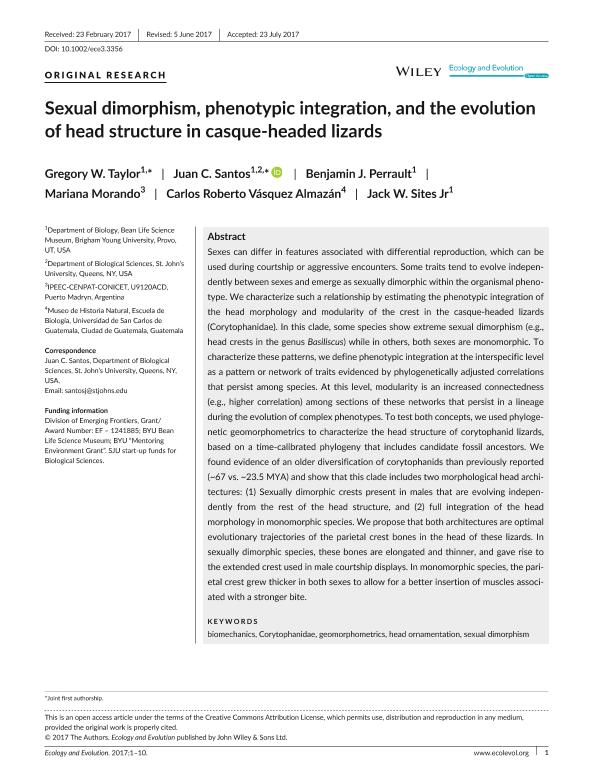Artículo
Sexual dimorphism, phenotypic integration, and the evolution of head structure in casque-headed lizards
Taylor, Gregory W.; Santos, Juan C.; Perrault, Benjamin J.; Morando, Mariana ; Vásquez Almazán, Carlos Roberto; Sites, Jack W.
; Vásquez Almazán, Carlos Roberto; Sites, Jack W.
 ; Vásquez Almazán, Carlos Roberto; Sites, Jack W.
; Vásquez Almazán, Carlos Roberto; Sites, Jack W.
Fecha de publicación:
09/2017
Editorial:
Wiley Blackwell Publishing, Inc
Revista:
Ecology and Evolution
ISSN:
2045-7758
Idioma:
Inglés
Tipo de recurso:
Artículo publicado
Clasificación temática:
Resumen
Sexes can differ in features associated with differential reproduction, which can be used during courtship or aggressive encounters. Some traits tend to evolve independently between sexes and emerge as sexually dimorphic within the organismal phenotype. We characterize such a relationship by estimating the phenotypic integration of the head morphology and modularity of the crest in the casque-headed lizards (Corytophanidae). In this clade, some species show extreme sexual dimorphism (e.g., head crests in the genus Basiliscus) while in others, both sexes are monomorphic. To characterize these patterns, we define phenotypic integration at the interspecific level as a pattern or network of traits evidenced by phylogenetically adjusted correlations that persist among species. At this level, modularity is an increased connectedness (e.g., higher correlation) among sections of these networks that persist in a lineage during the evolution of complex phenotypes. To test both concepts, we used phylogenetic geomorphometrics to characterize the head structure of corytophanid lizards, based on a time-calibrated phylogeny that includes candidate fossil ancestors. We found evidence of an older diversification of corytophanids than previously reported (~67 vs. ~23.5 MYA) and show that this clade includes two morphological head architectures: (1) Sexually dimorphic crests present in males that are evolving independently from the rest of the head structure, and (2) full integration of the head morphology in monomorphic species. We propose that both architectures are optimal evolutionary trajectories of the parietal crest bones in the head of these lizards. In sexually dimorphic species, these bones are elongated and thinner, and gave rise to the extended crest used in male courtship displays. In monomorphic species, the parietal crest grew thicker in both sexes to allow for a better insertion of muscles associated with a stronger bite.
Archivos asociados
Licencia
Identificadores
Colecciones
Articulos(IPEEC)
Articulos de INSTITUTO PATAGONICO PARA EL ESTUDIO DE LOS ECOSISTEMAS CONTINENTALES
Articulos de INSTITUTO PATAGONICO PARA EL ESTUDIO DE LOS ECOSISTEMAS CONTINENTALES
Citación
Taylor, Gregory W.; Santos, Juan C.; Perrault, Benjamin J.; Morando, Mariana; Vásquez Almazán, Carlos Roberto; et al.; Sexual dimorphism, phenotypic integration, and the evolution of head structure in casque-headed lizards; Wiley Blackwell Publishing, Inc; Ecology and Evolution; 7; 21; 9-2017; 8989-8998
Compartir
Altmétricas



